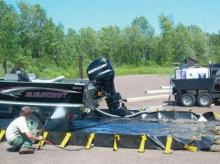Watercraft Inspection and Decontamination Programs

Many Western states instituted watercraft inspection and decontamination programs after the discovery of invasive mussels in Lake Mead in 2007 (Zook and Phillips 2012). As of 2018, nineteen states have implemented watercraft inspection and decontamination programs (Otts 2018).
This page contains resources on mandated watercraft inspection and decontamination programs, as well as some non-mandated but state-funded watercraft inspection efforts. This list below is not intended to be comprehensive, and all boaters should check with their relevant state agency before launching watercraft to ensure they comply with all regulations. To find U.S. state and territorial fish and wildlife agencies, see Members of the Association of Fish & Wildlife Agencies. And, see Watercraft Inspection Station Contacts [PDF | 277 KB].
View related information: Aquatic Invasive Species Decals
Spotlights
Videos
Selected Resources
The section below contains highly relevant resources for this subject, organized by source.
Partnership
Federal Government
State and Local Government
Citations
- Elwell, L. and S. Phillips, editors. 2016. Uniform Minimum Protocols and Standards for Watercraft Interception Programs for Dreissenid Mussels in the Western United States (UMPS III) [PDF, 9.67 MB]. Western Regional Panel on Aquatic Nuisance Species.
- Otts, S. 2018. From Theory To Practice: A Comparison Of State Watercraft Inspection And Decontamination Programs To The Model Legal Framework [PDF, 1.08 MB]. University of Mississippi School of Law, National Sea Grant Law Center.
